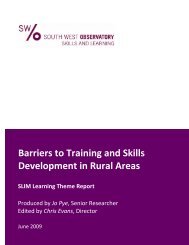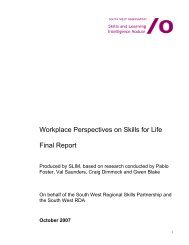Ageless at Work - Skills for Care
Ageless at Work - Skills for Care
Ageless at Work - Skills for Care
Create successful ePaper yourself
Turn your PDF publications into a flip-book with our unique Google optimized e-Paper software.
“[There is] little to suggest th<strong>at</strong> they [older workers] will be a high priority in the distribution of<br />
opportunities <strong>for</strong> training or support in workplaces” (Billet and van Woerkom, 2008).<br />
A number of studies of work-rel<strong>at</strong>ed training <strong>for</strong> lower skilled staff in the NHS have highlighted the<br />
important role played by managers (and the work organis<strong>at</strong>ion as a whole) in cre<strong>at</strong>ing the conditions<br />
<strong>for</strong> learning in the workplace (UKESC, 2009). Organis<strong>at</strong>ional barriers to skills development include:<br />
- Problems negoti<strong>at</strong>ing time off to train, especially <strong>for</strong> front-line staff, and especially if training is<br />
off-site;<br />
- The danger th<strong>at</strong> <strong>at</strong>tempts to foster a learning environment are undermined by other changes<br />
to the employment rel<strong>at</strong>ionship (<strong>for</strong> example, need <strong>for</strong> flexibility which may conflict with<br />
<strong>at</strong>tempts to promote evening or weekend working);<br />
- Unequal access due to specific views of line managers (who may <strong>for</strong> example, view investing<br />
in training <strong>for</strong> older workers as an inefficient use of resources);<br />
- Concerns among learners and managers regarding the value of N/SVQ-orient<strong>at</strong>ed training.<br />
Mcbride et al. (2006) identified a number of barriers to skills development faced by lower skilled NHS<br />
staff, including: managers’ conflicting priorities and limited resources to find cover <strong>for</strong> staff undertaking<br />
skills development activities; the time and distance associ<strong>at</strong>ed with getting to training centres<br />
(especially in rural areas); a lack of consistent in<strong>for</strong>m<strong>at</strong>ion about opportunities; and in some cases the<br />
sense th<strong>at</strong> managers had ‘r<strong>at</strong>ioned’ in<strong>for</strong>m<strong>at</strong>ion about opportunities to favoured staff (who may, <strong>for</strong><br />
example, view investing in training <strong>for</strong> older workers as an inefficient use of resources). This r<strong>at</strong>ioning<br />
is often based on the perception th<strong>at</strong> older learners are (VT Research, 2008):<br />
- More reluctant to train, especially if bordering on retirement<br />
- Showing fear or insecurity and lack of understanding of the need to train<br />
- Believing th<strong>at</strong> training is unnecessary<br />
- Finding it harder to learn new things.<br />
One [American] study (Peterson and Wendt, 1995) found th<strong>at</strong> a quarter of those aged 50 and over<br />
who had not trained ‘had not particip<strong>at</strong>ed in an educ<strong>at</strong>ional activity because their employer had not<br />
encouraged them to do so’. Given older workers lack of support - older workers need to be assertive<br />
in seeking educ<strong>at</strong>ional opportunities, but underlines the importance of managers in encouraging the<br />
ongoing development of older workers (Githens, 2007).<br />
While the appropri<strong>at</strong>eness of provision, and workplace issues and employer <strong>at</strong>titudes are important,<br />
extrinsic factors influencing older peoples’ <strong>at</strong>titudes to training, others include work and family<br />
commitments. The most frequently reported barriers to learning tended to rel<strong>at</strong>e to intrinsic factors (i.e.<br />
rel<strong>at</strong>ed to the individual’s <strong>at</strong>titudes, beliefs, knowledge and motiv<strong>at</strong>ion), of which the most frequently<br />
cited reasons were: a preference to spend time doing other things (43 percent), a perception th<strong>at</strong> they<br />
were too old to learn (35 percent), not being interested in learning (29 percent), insufficient knowledge<br />
about local learning opportunities (23 percent) and nervousness about returning to the classroom (22<br />
percent). The most common reasons <strong>for</strong> not particip<strong>at</strong>ing in learning among those who would like to<br />
learn include (Eurost<strong>at</strong> Adult Educ<strong>at</strong>ion Survey):<br />
<strong>Ageless</strong> <strong>at</strong> <strong>Work</strong>: Change workplace cultures, development skills. Good practice report 33








